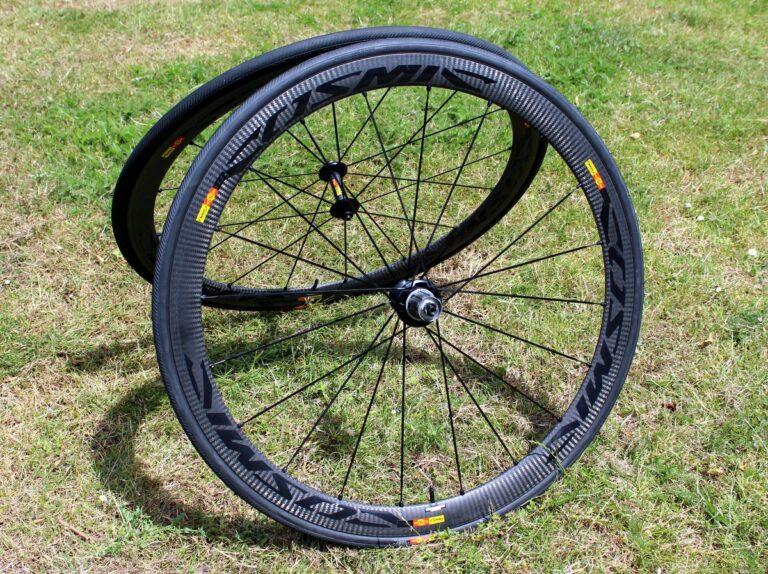With summer finally arrived, and the prospect of rain diminished for a few weeks at least, many of us will be removing our heavy duty winter tyres and fitting lighter, faster rubber.
While wear is easy to detect on a treaded tyre, the warning signs can be harder to find on rubber with a smooth, ‘slick’ surface.
‘Summer tyres’ are typically lighter, more supple, and with a softer, grippier compound than the high-durability rubber many of us choose for winter.

We caught up with Jon Hayes, mechanic at independent bike shop, Ride, to learn the tell-tale signs of worn summer rubber.
Checking for wear
While a slick tyre has no tread, the rolling surface is still subject to wear. As the rubber reduces, the ‘top’ of the tyre – the section in contact with the road – becomes flatter.
“A new tyre will have a very round profile, so when it’s up to full pressure, you’ll be rolling on a very small patch of rubber to keep the rolling resistance low,” says Jon.
As the tyre becomes worn, and the ‘top’ section flattens, the contact patch increases, and with it, rolling resistance. Additionally, the rubber becomes thinner with wear, and so easier for road debris to penetrate.

Jon warns that this flattening effect is most likely to occur first on the rear tyre – the ‘drive’ tyre. A quick examination of his own summer bike reveals that while the ‘flattening’ effect is already present on the rear tyre, the centre ridge and moulding marks are still in place on the front.
Providing the front tyre does not suffer cuts from stones or glass, it can last up to two or three times as long as the rear. Given their different wear rates, should a front tyre be replaced at the same time as the rear? “Ideally, keep a matching pair,” says Jon, “but if the front tyre’s in good shape, I wouldn’t change it just for the sake of it.”
If you’re riding to a budget, it’s possible to replace a worn rear tyre with a relatively unworn front tyre, and to fit a new tyre to the front. But Jon cautions that front and rear tyres perform a different task, and adds that manufacturers increasingly sell tyres with different compounds for their allotted roles as a designated pair.
Checking the sidewalls
Perishing is typically the first sign of wear on a tyre’s sidewall. Ultraviolet rays in sunlight and the chemicals in cleaning products are just two factors that can cause the sidewall to degrade, says Jon.

The dreaded ‘ping’ of an object hitting your spokes after escaping from beneath the tyre of a riding buddy should also give cause to check the sidewall. “If it’s a piece of glass or sharp flint, that can cut the sidewall of the tyre,” says Jon. “If they get knicked, they’ll open up.”
A very worn sidewall can take on a ‘furry’ appearance as the threads of the carcass emerge, but wear to the sidewall occurs at a much slower rate than to the rolling surface. Put simply, a tyre should have been replaced long before the sidewall has degraded.
Checking the bead
All other checks mentioned in this article can be performed with the tyre in place. To check the bead, however, you must remove it from the wheel.
The bead hooks the tyre to a clincher rim (tubular tyres or ‘tubs’ are glued to the rim) and are typically made from steel or Kevlar. The latter is much lighter and more likely to be a feature of a summer tyre.
Damage can be caused by constant removal and refitting or by the use of “heavy duty” tyre levers, says Jon. “If the bead is damaged, it won’t hook on to the rim effectively, and could be blown off by the pressure in the inner tube. Any damage to the bead – that’s a bin job.”
Checking for debris
Jon completes a visual check of his tyres before every ride, looking for small slashes that may allow a small stone or a piece of glass to work through the carcass of the tyre to the inner tube.
The offending items can be removed by any pointed object, but take care to ensure you do not cause further damage to the tyre.

“You’re not delving too deeply into the tyre,” Jon says. “If you gently squeeze the sidewalls of the tyre, the slit will usually open up and you can see the object.”
There isn’t a special tool available for the purpose. Any thin, pointed object, such as a door key, can be used to prise out the debris.
Many tyres contain a puncture protection belt, but if the object is large or sharp enough, even this defence may be breached, says Jon.
“If it’s a good quality tyre, the belt might be enough to keep that object at bay, but it’s still a good idea to remove debris, if only for peace of mind.”
Check back next week when Jon will give his tips on selecting a summer tyre





